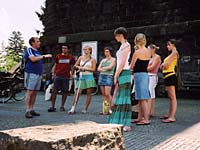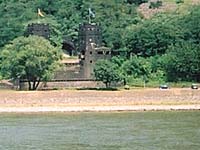
Home Page Project ListingsProject OverviewBackground / ContextLearning ResourcesUseful Links |
Remagen Bridge Project
School DetailsIn July 2005 8 A Level German students of St. John Fisher Catholic High School in Newcastle-under-Lyme, Staffordshire took part in an educational visit to the Rhineland in Germany. ActivitiesAs well as an opportunity to practice and improve their German language skills, the aim of the visit was to gain a greater appreciation of 20th Century German History and how the Second World War has shaped the Europe we live in today. Amongst other sites, the group visited the Peace Museum at Remagen Bridge, the Gestapo Prison & National Socialist Documentation Centre in Cologne and the Post-War History Museum in Bonn. During their tour of the Peace Museum in Remagen, students were to focus on the sacrifices made by both the Allied and German soldiers involved in combat, as well as the suffering of ordinary German Civilians in the area. Furthermore, students learned of the strategic significance of the capture of Remagen Bridge in terms of the Allied liberation of Nazi Germany. Under the motto of “Cross the Rhine with dry feet”, General Eisenhower recognised that the capture of Remagen Bridge was worth its weight in Gold in terms of speeding up the defeat of Nazi Forces on the Western Front, by allowing Allied forces to cross this last barrier without major resistance. As a result of the visit, students produced a piece of work on the events surrounding the capture of Remagen Bridge. In particular, students focused on why this event was so significant for the course of the war and tried to imagine how it would have felt to be an Allied Soldier or German Civilian at the time. In doing this, students gained a greater empathy for the sacrifices made by those soldiers involved and the everyday suffering of civilians. Upon their return, students created a display board regarding their visit to Cologne, a part of which was devoted to the Remagen Peace Museum. Furthermore they each wrote a piece about their visit, reflecting on their own personal feelings of it. Please find below an example of the work produced by the students and photographs of how the Remagen Bridge site appears today, now that the bridge has collapsed. Robert Schauer Remagen Peace MuseumOn Wednesday, 13th July 2005 during a class trip to Cologne, we visited the Remagen Peace Museum. We learned some very interesting facts and overall, I think that my opinion towards the war and those involved has completely changed.
The Remagen Peace Museum focuses deeply on the “Lüdendorff Bridge” and its involvement in the concluding phase of the Second World War. There is much research and evidence displayed portraying how Remagen was affected by Allied Bombing, the subsequent capture of the Bridge by Allied Soldiers and how life was for German POWs held in the Area. The “Lüdendorff Bridge” was built in 1915 during the First World War, to facilitate the transport of Soldiers and Weaponry to the Western Front. The Bridge played a key role in the German “Schlieffen Plan” to invade France. After the First World War, the bridge reverted to civilian use. However, at the beginning of the Second World War it became of strategic military importance again to facilitate the Nazi Blitzkrieg in the West. By 1944, following the Normandy landings, the Allied Military also recognised the strategic importance of these Rhine Crossings in supplying the German Forces in the West. As a result, the Allies began a bombing campaign on the Rhine to neutralise these bridges. These bombings deeply affected the region, in that there was a severe lack of bomb shelters. As a result, citizens were forced to flee into the surrounding woodlands and railway tunnels. In spite of this, during Autumn and Winter 1944 approximately 50 German Soldiers and Civilians were killed in the bombings around Remagen alone. As the Allied advance progressed during 1944/45 the Rhine became the last natural barrier on their advance towards Berlin. The Lüdendorff Bridge in Remagen was the last bridge that was left intact following the bombings. The bridge therefore became a key target for the Allies to capture to speed up their advance. In Early March 1945, the US 9th Army Division led by Timmerman launched a surprise attack to secure the bridge. On 6th March 1945 Hitler ordered that the bridge should be blown up. However, 5 Officers guarding the bridge, who were entrusted with this task, did not carry out these orders. It has been widely speculated that they deliberately disobeyed the orders, realising that resistance was now futile and that by not blowing up the bridge, this would bring the war to an end more quickly. Ultimately, however they made the ultimate sacrifice, as they were court martialed and shot as a result of their actions. Partly because of this, the US 9th Army were able to capture the bridge intact on 10th March and for the following 7 days the bridge became vital in transporting artillery, tanks and soldiers across the Rhine. The sign posted by soldiers on the bridge “Cross the Rhine with dry feet!” encapsulated just how importance this crossing was in the war effort. General Eisenhower too recognised its importance, stating that it was “worth its weight in Gold”. Finally on March 17th at approximately 3pm, the bridge finally collapsed due to the sheer weight of material being transported, and as a result 28 US soldiers were killed. However, the crossing was made and the Allied Forces were able to march East through the heart of Germany, helping to bring the War to a more swift end. I have learnt many new facts about the war from my visit of the Peace Museum and the German Postwar History Museum. It enabled me to understand the sacrifices made by German Soldiers and Civilians too – something that I had never really thought about before. It has certainly helped to break down some of the prejudices I had against the Germans, in understanding how they suffered too. Ultimately, the Peace Museum highlighted the tremendous sacrifices and waste of human life caused by war and this helps me to value the peace that we live in today. Sally Mawby |

